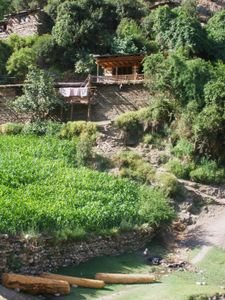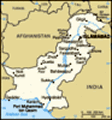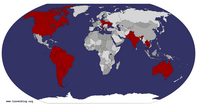Advertisement
Published: August 23rd 2008

 Balanguru
Balanguru
It's not what anyone would imagine when thinking of Pakistan...This place cannot be for real. It is not just another world, rather another galaxy. My initial fifteen minutes in Balanguru are of paralysis and disbelief. Balanguru is what it must be like to be knocked unconscious by an alien tractor beam and then relocated to their home solar system. Distance, introversion, and geographical inaccessibility have shielded the Kalash people from mainstream Pakistan for centuries. An agrarian and independent civilization, they have rejected Islam and maintain their long-standing practice of ancient paganism. Their customs are on display without the slightest hint of showmanship.
Ameen and Simon unload the jeep at the guesthouse while I aimlessly roam downhill in the direction of the small bazaar. Simon is unaffected by the transition into this alternative world. I do not know if it is indifference or an inner trait that prevents him from expressing sheer awe. He is not as stupefied as I am. He gingerly wanders into the room we have chosen and lies down on the bed. In a way, he is dazed after all; his mysterious illness still hounds him. He is sapped of all energy. I grab for my pack and toss it around my shoulder. I need to ingest

 Corn Crops
Corn Crops
Much of Kalash is self-sufficient, starting with agriculture...more of what I just saw when arriving from the passenger seat of the jeep.
The Kalash are self-sufficient in every imaginable way. They reside in firm homes of mortarless flat stone through which heavy horizontal timber beams are set to reinforce the exterior. Some are perched into the shelved hills above rows of corn or alongside irrigation canals. They are a cross between walls of smooth, chiseled rock and a log cabin. Above the cornfields fruit trees bear apples and plums. Heavy and copious bunches of sweet purple grapes strain the stems connecting them to undomesticated vines. The crashing into boulders and cliffs of the Rambur River produces a reverberating sound like that of an oscillating fan.
Youthful boys in a shalwar kameez (the typical Pakistani pajama top and trouser combination) willingly hunch together shoulder to shoulder to pose for photographs. They giggle at their images on the display of my digital camera although they fully know they cannot attain a copy for themselves. Almost all of the boys sport the same style, forest green baseball cap with “Pakistan” and the crescent and star printed in white as a sort of school uniform. By the time they reach adulthood,

 Mortarless Conctruction
Mortarless Conctruction
Homes are sturdy and even on the surface...the caps are replaced by woolen toppees, but they still adhere to their traditional tops and trousers.
The girls and women are doubtlessly the primary visual showpiece of the Kalash region. Well aware of their unique attire, many even at a young age understandably shy away from tourists, especially when withdrawing a camera for a snapshot. Kalash women dress in ornately decorated one-piece black outfits from neck to ankle. From the top of the chest to the back of the shoulders runs stitched embroidery, often in bright orange, pink, or yellow. A stringy sash hangs from the waistline in colors that may or may not match other areas of their dress. The trim at the bottom of their dress is no less fancy, often in a floral or symmetrical pattern design. The most eye-popping piece of their attire is an open circular band atop their heads. It is of varying colored beads and ornaments, the length of which runs in a wide strip almost to the small of their backs. The girls’ appearance is irresistibly striking and reinforces that there exists an unmistakable fissure between their lifestyle and that of mainstream Islamic Pakistan.
Simon, Ameen, and I hike up a

 Swamped
Swamped
All of a sudden, the girls were much more cooperative when they saw one of their own receiving a gift...hill where at the top there is a viewpoint of Balanguru. The covered, spacious, and dusty platform serves as a stage for dance performances and festivals during the summer and winter solstice. The main difference between here and other “traditional” regions of indigenous cultures is that the Kalash perform for real. In other words, they do not deck themselves out for the benefit of outsiders’ pleasure and curiosity. They are the real thing; once the nocturnal performance is over, none of the girls fall back into halter tops and mini-skirts or a burqa for that matter.
With much coercion through Ameen and with a twinge of guilt, one of the girls in the group that followed up the stairs agreed to pose for a photo. Earlier I delicately tried to capture an image of another without her consent and the six-year-old grabbed some pebbles in her hand and motioned to throw the pile at me if I dared click my shutter. I will never forget how she scowled at me with a nasty, bitter expression that shattered the image of innocence I had of them and the rest of Balanguru. Ameen quipped, “I think she wants money before you can

 A Touch of Connecticut
A Touch of Connecticut
I never expected she woulod use it as an earring...take her photo.”
The master of the obvious hadn’t enlightened me. “Yeah, I got that. Can you tell her to put the stones down? I don’t want to get pelted.”
“No, I cannot, sir.” Wait a minute. You’re supposed to be my tour guide. You work for me! “Sir, just put the camera away.” I did and the pebbles fell to the ground, but she never took her eyes off me. I never took my hands off the camera in my front pocket. The game of cat and mouse would continue.
“And just why didn’t you tell her, Ameen?” I asked in a frustrating tone.
“She cannot understand Urdu. I do not speak Kalash.” In other words, with the exception of the educated men in the village who are functional in Urdu, Ameen from Gilgit is as linguistically lost and just as much as an outcast as his American and Scottish clients.
One gentler and more cooperative girl did approach me and did not flinch when I showed her my camera. I fired a series of clicks at her face and dress in hopes that one would come out well. To thank her for her cooperation, I showed her a

 Ameen Connects
Ameen Connects
Kalash children gather round...blue Connecticut lapel pins from my day pack and let her see it. It clashed with her mountain attire of black, orange, pink, and green. The tiny accessory simply did not belong on her. As soon as she took it the rest of the pack hounded her for it and then struck poses for me; they coveted the pin. Sorry girls, you lose.
I usually affix the pins to people, but it would have felt awfully out of place for me to do that here. The girl looked at the two pieces and particularly the clasp. Since she had never seen one before, she took it as an earring and fastened into her left lobe. It looked a bit silly, graceless even. She loved it and showed it off to the rest of her friends whom I ignored even as they continued to strike positions that would be endearing to any camera lens. While delighted I made her happy, overall the incident did not please me. The coaxing and wheedling for a few rupees depressed me. That pin did not belong on her and I had a guilt-ridden feeling like those in Kalpa and Duikar. Simon’s and my presence in

 Simon and Ameen
Simon and Ameen
Simon's smile masks his fatigue and coughing...Balanguru will have done little to help these people preserve their lifestyle. Visitors infiltrate Balanguru all the time, but we were the only Westerners in the village at the time. As their eyes were on our odd features, our stares were geared to their braided hair, outlandish attire, and pastoral existence. There was no common ground. It was impossible to connect.
Some boys arrive to join the fray. One carries a slingshot and projects large stones well into the air over the village. Where they land in the community of four hundred is anyone’s guess: on a roof, in a cornfield, or perhaps one will smash against a jeep. I have anointed him the Bart Simpson of Balanguru. The boy continues to combat his inner boredom by flinging stones for several minutes in full view of idle adults who neither do nor say anything to stop him. The grimy boy goes on unrestrained, calling into question the Kalash’s sense of order and discipline. The girls get involved in a game of tag and kick up funnels of dust.
The Kalash’s features put them at odds with the stereotype of the average Pakistani. Although the women have darker hair and olive

 Doable
Doable
It was the next bridge over the rushing river, nothing more than a flattened log, that exposed my fear...skin, many of the men come across as Swedes with a tan. It is no surprise to see farmers, pick axe or walking stick in hand, with green eyes and thick, light hair neatly parted down the left side. The Kalash do not customarily grow their beards long and unwieldy like Muslims. A closer peek at their sideburns discloses reddish highlights when in sunlight.
Their isolation from the rest of Pakistan permits them to practice a pagan religion without the fear of conflict or tension. Where once outsiders from Chitral and beyond wanted them to convert to Islam, it is now in the government’s best interest for the Kalash to preserve their religious observances as a source of tourist revenue. However, seclusion comes at a price that the average Westerner would be unwilling to pay. Many of Balanguru’s young have never left the valley. Girls are married off in their early teens and soon have children. One family where I stopped for tea had a daughter of twenty-three with four children; the mother’s face was that of a woman fifteen years her senior. Her hands were deeply calloused with thin, bony fingers. Another girl of sixteen was nursing her two-year-old

 Shaded Meadow
Shaded Meadow
A walk above Balanguru...daughter in a corner. Education is not compulsory though there has been a school in the village for twenty years. Through an interpreter, I asked the shepherd in whose home I was invited why more children, girls in particular, do not go to school.
“Why should they? Who would tend to the crops and children?”
Urdu is taught in the schools, but few of the girls or women speak it, ensuring that their incarceration in the Kalash Valleys will never be challenged. There is no possibility of learning English. Many of the men, on the other hand, speak very acceptable Urdu and some can converse in English, an unattainable and unnecessary luxury for their wives and daughters.
Simon’s illness still has not remedied itself. He has remained back in the room near a toilet, has had no appetite, and he is now and then powerless to sit up. He often complains of joint pain. An easy two-hour trek earlier in the day shattered him. Having bypassed dinner, his condition is now a concern for Ameen and me. It has been two days and still no improvement in spite of an accumulation of pharmaceuticals he has ingested to fight off the symptoms. “I do not what I should do at the toilet when I get there, Rich. It is either kneel down or sit on it. And I cannot decide until the last moment.” Ameen and I hover over him. “Have you lost any weight in the last week, Simon?” I inquired.
“It has been considerable.”
I escorted Ameen out of the room to the garden. “Look, here’s what we have to do. We leave tomorrow anyway for Chitral. He has trouble walking. How’s the hospital in Chitral?”
“There is one there.” Not exactly the answer to my question, but it will do. I doubt I could have expected much more detail of the medical infrastructure in Northwest Pakistan, tucked up against Afghanistan. The border was less than fifteen miles away.
“If he starts to crash, I mean worsen, overnight, we have to pack and leave for Chitral in the dark. I won’t take any chances. If things do not improve, we’ll have to make decisions for him. Are you OK to move on that road at night?”
“Yes, sir! I will do whatever you need. I will be ready to go!”
“Good.”
I ask Ameen to accompany me to the same covered stage for an evening dance soirée where we met the girls earlier. I can use him as an interpreter with the older men or at least he can give me an idea of what was going on; he has been to Kalash at least twice before. In the dark, the girls hold onto each other arm around waist six across and sprint around the stage while incoherently chanting until they come to a stop out of sight. About five or six groups perform these motions to the beat of three drummers, boys who continuously smash large drums strapped to their shoulders. Other boys, in their pre and early teens not participating in the dance, gather around the edge and watch the girls. They make comments and smoke cigarettes. As non-Mulsims, some pass a locally fermented liquor to each other and swig it from a cloudy plastic water bottle. The girls come and go out of the dark and repeat the dance steps, but there is little order and most certainly no instruction. While intriguing at first their routines become tedious, but I cannot get over how foreign it feels to be among them.
Some of the girls take a break and run off with the boys into the dark for only thirty seconds or so. They come back smelling like a pack of Camels. No adults over the age of twenty-five are to be found. Everything is self-directed by the children. I lean into Ameen, “This is not Pakistan. Not at all.”
“I thought Gilgit was different from Islamabad until I came here”, he replies. The girls are less timid at night and the women when they spot me can be downright frisky with their hands on my thighs. Yes, I am not in Lahore anymore.
Some of the girls tell Ameen that a fifteen-year-old, soon to be married, has yet to pass the fourth grade. Sitting on the steps illuminated by a solitary naked lightbulb, one spoke up for the group saying that only one girl from the village had made it as far as Chitral, not exactly a great accomplishment. Intermarriage with boys from the neighboring Bamboret valley is rare, resulting in a very limited gene pool. None of the girls know where or what Islamabad is and could only agree that there is such thing as Pakistan because that’s what they are told in school. No girl without exception has ever heard of the Unites States. This strikes a deep chord with me. Not know where my country is on the map? OK. Not give a damn about the U.S.? Fine, no problem. But even in the deepest jungles of Laos and most far off shacks in Honduras I would expect my country, the most omnipresent in the history of the world, to generate some recognition when its name is spoken. With these girls, there is no chance. As far as they are concerned, we come from a far off land; all foreigners are from elsewhere. Elsewhere simply means you are not from the valley.
I can only hold them up for so long until they go back to their very sloppy rehearsal. The girls are tough and among them is a strict pecking order. When one steps out of line, an older one slaps her and hunts her down to deliver a few blows. None of the Kalash is highly refined. Though there is order, do not confuse this for any Western concept of law or discipline. Interlopers such as Simon and I will slowly erode their traditions, including a rough but innocent approachability, until they become the Amish of Pakistan. Until now no one has told the Kalash what to do. And they plan to keep it that way for as long as possible.
Ameen and I walked back to the guesthouse by flashlight and the sound of the Rambur River. While kicking stones and avoiding a hazardous fall over a drainage pipe or small log, I replayed in my mind the sensation that overwhelmed me when I first set foot in Balanguru. Now on the eve of my leaving the Kalash Valley, some of the bewilderment is gone, but not the admiration I have for the toughness and resilience of its people. I can go back to Chitral knowing full well that despite my esteem for the Kalash, the utopian Himalayan kingdom depicted in The Lost Horizon is still a work of fiction.
Advertisement
Tot: 0.203s; Tpl: 0.014s; cc: 28; qc: 95; dbt: 0.1448s; 1; m:domysql w:travelblog (10.17.0.13); sld: 1;
; mem: 1.4mb






























